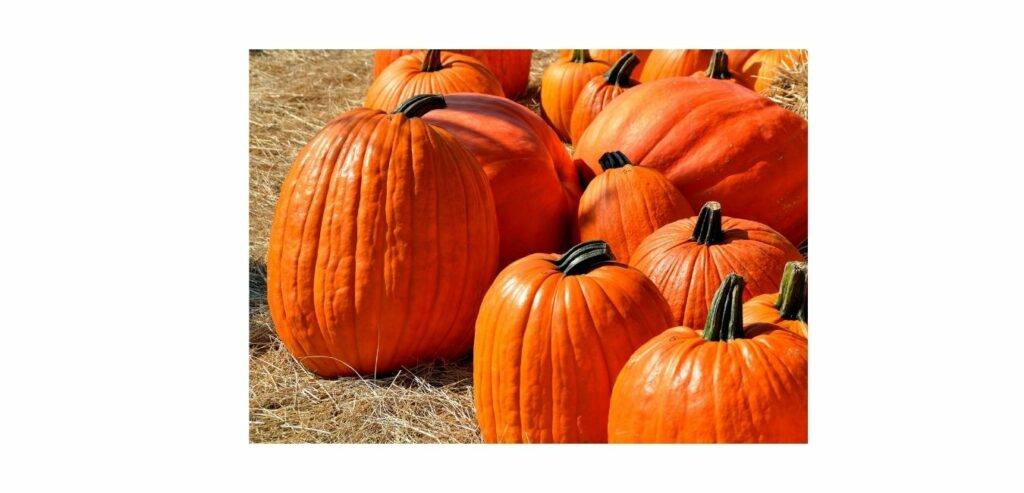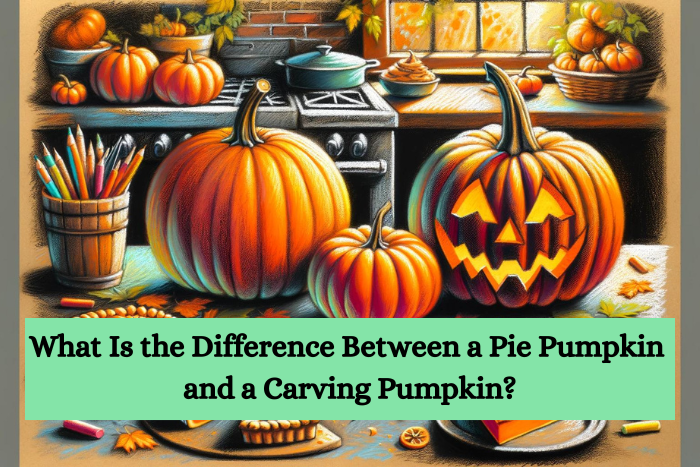Pie pumpkins are smaller, with thicker, sweeter flesh and thinner skin, ideal for cooking. Carving pumpkins are larger, have a blander, stringier flesh, and are better suited for decoration. Key differences include size, flesh texture, taste, and skin thickness.
October is here. And that means, yes, you guessed it!
Pumpkins! The stores have large containers of them for sale.
If you live in a rural area as I do, then you will see signs for pumpkins for sale. Pumpkins are not just for carving that Jack-0′- lantern for Halloween, however.
Let’s not forget about that tasty pumpkin pie. Or bread.
Oh wait, let’s not forget pumpkin bars or pumpkin rolls either. But what is the difference between a pie pumpkin and a carving pumpkin?
Is there a difference? There sure is!
Is a regular or a carving pumpkin edible? Yes, but you will be disappointed in the taste.
The biggest difference between a pie and a carving pumpkin is what is inside the pumpkin. The flesh. But there are other differences as well. The color, the size, the skin. and the taste.
The Color
A pie pumpkin is a deeper orange color on the outside while the carving pumpkin may be a lighter shade. But you can’t always depend on this.
I have seen the larger carving pumpkins with a deep orange color on the outside as well.
The Size
A pie pumpkin is smaller than a carving or regular pumpkin.
The Skin
The skin of a pie pumpkin is thinner than the carving pumpkin. Which makes peeling the pie pumpkin so much easier
The Flesh
The flesh of a pie pumpkin is a deeper orange color and thicker than the carving pumpkin. The carving pumpkin flesh is much thinner and very stringy.
The Taste
The pie pumpkin has a sweeter taste to it. While the carving pumpkin is edible, the taste is very bland and watery.
Many years ago I decided that I wanted to put up some pumpkin and freeze it. That way I would have it at Thanksgiving time.
It makes it so much easier if you have a vacuum sealer, too!
I could just go to the freezer and pull out a bag to make pumpkin pies for the holiday. It was a lot of work for no more pumpkin than I use in a year.
But if you have a large family and use a lot of pumpkins, then the work is worth it. My husband’s boss’s wife told me just the other day that she had never bought a can of pumpkin.
She and her mother put away the pumpkin and split the goods, so to speak. I have found in recent years that I crave pumpkin this time of year, so I think I will attempt to put some in the freezer next year.
As my husband loves growing pumpkins for the grandkids to carve, I think I will pick up some pie pumpkin seeds for him to plant as well.
There are many different varieties of pumpkins. Some types are best for carving and some are better for cooking.

Pie Pumpkins
- The small sugar pumpkin is considered the standard for pie pumpkins. They weigh from 6 to 8 pounds with thick sweet sugary flesh. The skin is a nice orange-yellow. An excellent choice for pies, baked goods, and canning or freezing as well.
- Triple Treat Pumpkin lives up to its name. The first treat: the hull-less seeds are perfect for roasting. The second treat: the shell is great for carving and the third treat: the flesh is delicious for eating. They weigh about 8 pounds but to get the sweetest flavor, harvest them when they are a little smaller. I am intrigued by this pumpkin and believe that this is the seed I am going to get for next year.
- Dickinson Pumpkin makes an excellent pie filling. Did you know that Libby’s Pumpkin puree is made from “Libby’s Select Dickinson” pumpkins? This seed is not available commercially but you can get it on Amazon.

Carving Pumpkins
- Howden’s Field Pumpkin is a favorite for Halloween. They weigh from 15 to 25 pounds. They are bright orange and slightly flat-faced with strong stems and extra-thick flesh.
- Connecticut Field Pumpkin is a nice rounded-shaped pumpkin with flattened ends and weighs about 20 pounds.
- Knucklehead Pumpkin is a warted pumpkin that is perfect for decorating or carving.
My Final Thoughts
- Pie pumpkins, or sugar pumpkins, are smaller and sweeter than carving pumpkins, making them ideal for baking and cooking, similar to how Granny Smith apples are often preferred for pies due to their tart flavor and firm texture.
- Carving pumpkins have a larger, hollow structure and thinner walls that are not as sweet or flavorful. This makes them better suited for decorations, akin to how larger pumpkins are prominently used during Halloween for jack-o’-lanterns.
- The flesh of pie pumpkins is denser and smoother, which is optimal for creating creamy pumpkin puree for recipes like pumpkin soup or pie, similar to how certain potatoes are better suited for mashing or baking based on their texture and moisture content.
- Carving pumpkins can be used for cooking but may result in a more watery and less flavorful dish, paralleling how certain vegetables like zucchini can be runny and less flavorful when overgrown.
- Despite these differences, both types of pumpkins are edible. They can be used interchangeably in recipes, requiring adjustments for sugar and moisture, just as different types of tomatoes can be used in sauces but may need tweaking in seasoning and cooking time.
There are several differences between a pie and a carving pumpkin. The size, color, flesh, skin, and taste.
While your regular or carving pumpkins are edible I wouldn’t recommend it. The flesh has a bland taste and is very stringy, and watery.
You will be very disappointed in the taste and texture of that pumpkin pie or bread you decided to make. There are many different varieties of pumpkins.
Some are better for carving while others are better for cooking. But then there are the ones that can act as both such as the triple treat pumpkin mentioned above.
Hmm, very intriguing. I hope you enjoyed this little article regarding the difference between a pie pumpkin and a carving pumpkin.
Please leave me a comment below with your thoughts. And as always, have a wonderful day!
FAQ: What Is the Difference Between a Pie Pumpkin and a Carving Pumpkin?
1. What are the main differences between pie pumpkins and carving pumpkins?
- Flesh and Taste: Pie pumpkins have thicker, sweeter flesh which is ideal for cooking and baking, resulting in more flavorful pumpkin dishes. Carving pumpkins, on the other hand, have a blander, stringier, and more watery flesh which is less suitable for consumption.
- Size and Skin: Pie pumpkins are generally smaller with thinner skin, making them easier to handle and cook. Carving pumpkins are usually larger and have thicker skin, which helps them hold up better when carved but makes them less desirable for cooking.
2. Can I use a carving pumpkin for making pies?
- Not Recommended: While technically edible, carving pumpkins do not yield the best results for pies or other pumpkin-based dishes due to their bland and watery taste. It’s better to use pie pumpkins for cooking to ensure a richer, sweeter flavor.
- Alternative Uses: If you have an excess of carving pumpkins, they can still be used in recipes where their texture and blandness are less noticeable, such as in a pumpkin soup where spices and other flavors predominate.
3. Are there any pumpkins that can be used both for carving and cooking?
- Triple Treat Pumpkin: This type of pumpkin is versatile; its seeds are ideal for roasting, its flesh is good for eating, and its shell can be carved, making it a multipurpose choice for both culinary and decorative uses.
- General Guidance: While some pumpkins like the Triple Treat are versatile, it’s generally best to choose the type of pumpkin that best suits your primary need—cooking or carving—to get the most out of its specific qualities.

I’m Diane, a culinary enthusiast who loves to share my cooking adventures and knowledge with you.
This blog is my cozy corner on the internet where I unravel the secrets behind making everyday cooking simple, enjoyable, and downright delicious.
Whether it’s unlocking the flavor potential in chicken or figuring out why your mashed potato cakes won’t hold together, I’m here to guide you through.
Join me as we explore various dishes, solve common kitchen dilemmas, and discover new recipes that will make you fall in love with cooking all over again.
Cooking is an adventure that’s best shared, so let’s get started!

